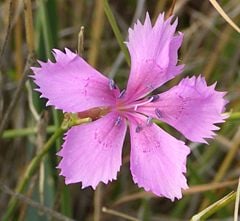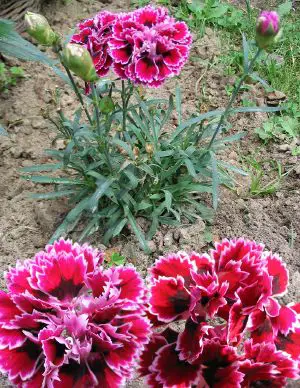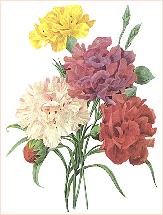Carnation
| Dianthus caryophyllus | ||||||||||||||
|---|---|---|---|---|---|---|---|---|---|---|---|---|---|---|
 Wild Clove Pink in flower, Turkey
| ||||||||||||||
| Scientific classification | ||||||||||||||
| ||||||||||||||
| Dianthus caryophyllus L. |
Carnation is a common name for a herbaceous, perennial plant, Dianthus caryophyllus, of the Caryophyllaceae family, widely cultivated for its flowers. The term also is used for the showy, variously colored, often fringe-petaled and fragrant flowers of the cultivated forms of this plant, also known as clove pink.
Garden (or border) carnations are among the most popular flowers, and are particularly important commercially as cut flowers, including in floral arrangements and corsages. There are many varieties of carnations that have been developed over the years.
Overview and description
The carnation, Dianthus caryophyllus, is a member of the flowering plant family Caryophyllaceae, commonly called the pink family or the carnation family. SThis is a large family with 88 genera and some 2,000 species. Most are herbacaceous annuals or perennials, dying off above ground each year. The leaves are almost always opposite, rarely whorled. The blades are entire, petiolate and often stipulate. The hermaphroditic flowers are terminal, blooming singly or in branched or forked in cymes. The flowers are regular and mostly 5-merous, i.e. with 5 petals and 5 sepals, but sometimes with 4 petals. The petals are fringed or deeply cleft at the end.
Within Caryophyllaceae, carnations belong to the Dianthus genus. Dianthus includes about 300 species of mostly perennial herbs, with a few annual or biennial, and some are low subshrubs with woody basal stems. The leaves are opposite, simple, and mostly linear. The flowers have five petals, typically with a frilled margin, and are (in almost all species) pale to dark pink. (One species, D. knappii, has yellow flowers with a purple center.
The carnation, Dianthus caryophyllus, is a herbaceous perennial plant growing to 80 centimeters tall. The leaves are glaucous grayish green to blue-green, slender, up to 15 centimeters long. The flowers are produced singly or up to five together in a cyme; they are 3–5 centimeters diameter, and sweetly scented; the original natural flower color is bright pinkish-purple, but cultivars of other colors, including red, white, yellow and green, have been developed.
The carnation is probably native to the Mediterranean region but its exact range is unknown due to extensive cultivation for the last 2,000 years.
Cultivation and uses
Carnations require well-drained, neutral to slightly alkaline soil, and full sun. Numerous cultivars have been selected for garden planting. Typical examples include 'Gina Porto', 'Helen', 'Laced Romeo', 'Red Rocket'.
Carnations are often worn on special occasions, especially Mother's Day and weddings. They were known as "Jove's Flower" in ancient Rome as a tribute to one of their beloved gods. In Korea, red and pink Carnations are used for showing their love and gratitude toward their parents on Parents Day. (Korea does not separate Mother's Day and Father's Day, but has Parents Day on May 8.) Sometimes, you can see old parents wear a corsage of Carnation(s) on their left chest on Parents Day. Not only on Parents Day, but also on Teacher's Day (May 15), people express their admiration and gratitude to their teachers with Carnations, as Carnation has the meaning of 'admiration', 'love', and 'gratitude'.
For the most part, carnations express love, fascination, and distinction. Light red carnations represent admiration, while dark red denote deep love and affection. White carnations indicate pure love and good luck; striped symbolize a regret that a love cannot be shared. Green carnations are for St. Patrick's Day, and, in the 19th Century, were used as a secret gay code; purple carnations indicate capriciousness. In France, it is a traditional funeral flower, given in condolence for the death of a loved one. Pink carnations have the most symbolic and historical significance. According to a Christian legend, carnations first appeared on Earth as Jesus carried the Cross. The Virgin Mary shed tears at Jesus' plight, and carnations sprang up from where her tears fell. Thus the pink carnation became the symbol of a mother's undying love, and in 1907 was chosen by Ann Jarvis as the emblem of Mother's Day, now observed in the United States and Canada on the second Sunday in May. A red carnation may be worn if one's mother is alive, and a white one if she has died.
In some cultures, however, especially the French culture, the carnation symbolizes misfortune and bad luck.
The Carnation is also the birth flower for those born in the month of January.
At Oxford University, carnations are traditionally worn to all examinations; white for the first exam, pink for exams in between and a red for the last exam.
Etymology
Some scholars believe that the name "carnation" comes from "coronation" or "corone" (flower garlands), as it was one of the flowers used in Greek ceremonial crowns. Others think the name stems from the Latin "carnis" (flesh), which refers to the original color of the flower, or incarnacyon (incarnation), which refers to the incarnation of God made flesh.
Although originally applied to the species Dianthus caryophyllus, the name Carnation is also often applied to some of the other species of Dianthus, and more particularly to garden hybrids between D. caryophyllus and other species in the genus.
ReferencesISBN links support NWE through referral fees
C. Stace, R. van der Meijden (ed.) & I. de Kort (ed.) Dianthus caryophyllus, Flora of NW Europe, The World Biodiversity Database, 2005. Retrieved October 18, 2007.</ref>
Dianthus caryophyllus, Flora Europaea, Royal Botanic Garden Edinburgh, 2002. Retrieved October Flora Europaea Search Results
Marjorie Blamey, Christopher Grey-Wilson. The illustrated flora of Britain and northern Europe, London: Hodder & Stoughton, 1989. ISBN 0-340-40170-2</ref>[1]
External links
All links retrieved September 30, 2007.
- Wikibooks' Gardening-Carnations, Wikibooks, the open-content textbooks collection.
- Carnations and Pinks Resources, BlueWorld Gardener.
- Carnations and the Floriculture Industry: Records of the Colorado Flower Growers Association, Colorado State University, Libraries, 2007.
Credits
New World Encyclopedia writers and editors rewrote and completed the Wikipedia article in accordance with New World Encyclopedia standards. This article abides by terms of the Creative Commons CC-by-sa 3.0 License (CC-by-sa), which may be used and disseminated with proper attribution. Credit is due under the terms of this license that can reference both the New World Encyclopedia contributors and the selfless volunteer contributors of the Wikimedia Foundation. To cite this article click here for a list of acceptable citing formats.The history of earlier contributions by wikipedians is accessible to researchers here:
The history of this article since it was imported to New World Encyclopedia:
Note: Some restrictions may apply to use of individual images which are separately licensed.
- ↑ Anthony Huxley, ed. Dictionary of gardening, New York: Stockton Press, 1992, ISBN 0-333-47494-5.

